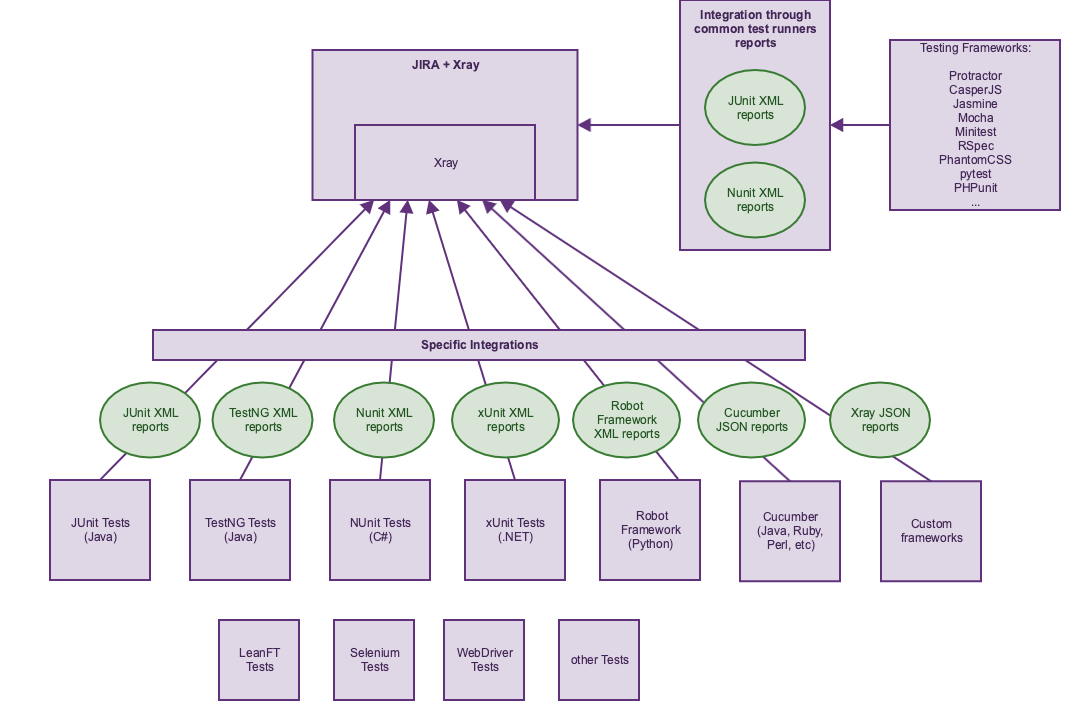Integration with testing frameworks is achieved by processing the results contained in the reports test runners (e.g., in XML, JSON). The results are mapped to the proper Test issues; if they don't exist then they will be created. This flow is explained in Using Generic Tests for Automation. Xray also supports Cucumber tests natively.
Besides Cucumber, there are currently many testing frameworks available for every language you may think of.
Many of these frameworks provide test runners that are able to output reports in the JUnit XML format. In the "worst" case, your automated tests can be imported to Jira and mapped to "Generic" Test issues by importing JUnit XML test result reports, as detailed in Taking advantage of JUnit XML reports. Note that the JUnit report format is rather limited and is not supported by some testing frameworks. Java users may prefer to use TestNG instead. Xray supports TestNG reports as detailed in Taking advantage of TestNG XML reports. Xray also supports XUnit reports.
Another way of integrating with testing frameworks is by using the NUnit test runner's XML report format. The NUnit report format has more features than JUnit 4.0 XML report, which allows Xray to do things such as automatic linking to issues (e.g., requirements) or assignment of labels to the newly created Test entities.
Besides this, Xray also provides specific integration for Cucumber and related variants.

Summary of features per framework
The following table presents the available features when importing automated test results.
JUnit 4 | TestNG | NUnit 2.6/3.x | xUnit 2 | Cucumber | Robot Framework | Xray JSON | |
|---|---|---|---|---|---|---|---|
Abstract automated test as a Test (map an automated test to a Test issue in Jira) | Yes (as a Generic Test) | Yes (as a Generic Test) | Yes (as a Generic Test) | Yes (as a Generic Test) | Yes (as a Cucumber Test) | Yes (as a Generic Test) | No Tests must exist beforehand |
Make Test specification in Jira (specify the Test itself in Jira) | No | No | No | No | Yes | No | Yes |
Create Tests from results (create Tests whenever importing results) | Yes | Yes | Yes | Yes | No* (but there is and endpoint for importing Cucumber features, which will create Tests for the respective Scenarios/Scenario Outlines) | Yes | No |
Uniquely identify Tests (identify existing Tests whenever importing results, avoiding duplication of Test issues) | Yes | Yes | Yes | Yes | Yes | Yes | Yes* (based on the provided Test issue keys) |
Import results (importing results by REST API or UI) | Yes | Yes | Yes | Yes | Yes | Yes | Yes |
Import “labels” (create labels in the Test issues) | No | Yes (labels may be specified in the test's source code) | Yes (labels may be specified in the test's source code) | Yes (labels may be specified in the test's source code) | Yes* (this is only available when using the endpoint for importing Cucumber features; it's not possible when importing results) | Yes (labels may be specified in the test's source code) | No |
Automatic linking to requirements (create links to requirements) | Yes* (requirement's issue key may be specified in the JUnit report) | Yes (requirement's issue key may be specified in the test's source code) | Yes (requirement's issue key may be specified in the test's source code) | Yes (requirement's issue key may be specified in the test's source code) | Yes* (this is only available when using the endpoint for importing Cucumber features; it's not possible when importing results) | Yes (requirement's issue key may be specified in the test's source code) | No |
Semantic on the results (present execution details in the execution screen) | - | Yes (for every "test" section in the XML config file and parameterized Tests) | Yes (Test Suites and parameterized Tests) | Yes (parameterized Tests) | Yes (steps for Scenario/Scenario Outline and Background) | Yes (keyword “steps”) | Yes* (semantic is implicit, because the Test must be created beforehand) |
